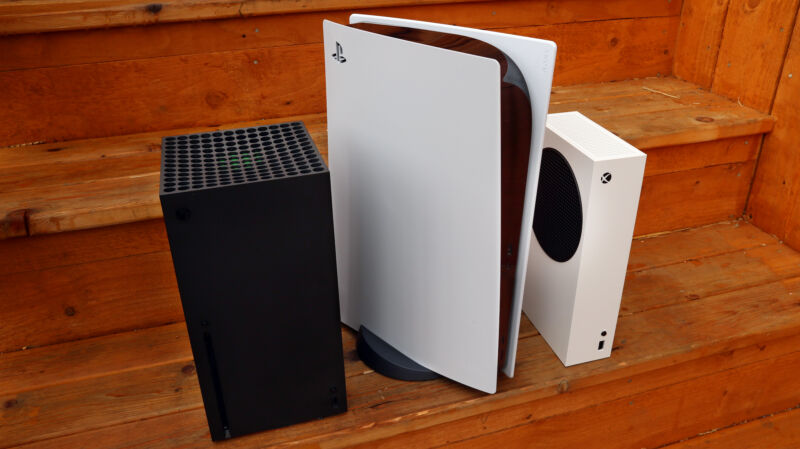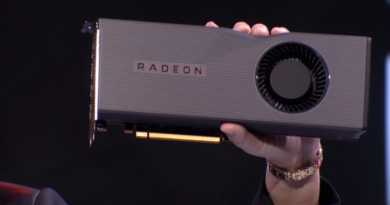Xbox Series X/S vs. PlayStation 5: Our launch-month verdict
[ad_1]

Sam Machkovech
Though this year’s newest consoles have only been on store shelves for less than two weeks, we’ve already published tens of thousands of words about the Xbox Series X/S and the PlayStation 5. Between months of tech previews, picture-filled unboxings, comprehensive reviews, coverage of some of the biggest launch games, and more, you could spend all day doing nothing but reading our detailed thoughts about Sony and Microsoft’s new consoles.
If you don’t have the time for all that, we understand. That’s why we’ve put together this handy, head-to-head summary comparing the most important features of both systems directly. By the end, we hope you’ll know if it’s time for you to upgrade your console, and which path you should take if it is.
Hardware design
-
Both systems add a little bit of visual flair when you look at them from an angle.
Sam Machkovech -
The Xbox Series X is plenty big, too, but it doesn’t compare to Sony’s big boy.
Sam Machkovech -
As far as horizontal footprints go, it’s no contest.
Sam Machkovech -
With its stand attached in horizontal position, PlayStation 5’s body (with white shell attached) maxes out at roughly 4.25 inches high. Xbox Series X’s horizontal orientation is a bit taller, at 6 inches of height.
Sam Machkovech -
If you can’t tell, the PlayStation 5 is bigger.
Sam Machkovech -
Xbox Series S posing on top of a PlayStation 5.
Sam Machkovech -
Seems even bigger from above.
Sam Machkovech -
Even horizontally, the PS4 Pro has quite a bit of height compared to previous PlayStations.
Sam Machkovech -
From square to rectangle.
Sam Machkovech -
Step aside, PS3 Phat—the PlayStation line has a new big boy.
-
PS5 vs. PSOne vs. PS Classic.
Both the PS5 ($499 with disc drive, $399 without) and the Xbox Series X ($499) are really big. The Series X astounds as a chunky, minimalist cuboid, with a minimum 6″ clearance on any of its sides—making it a nightmare for an average entertainment center’s shelves. The PS5 gets its minimum clearance down to 4.25″, but that comes at the cost of being 50 percent bigger than Series X in total volume. Once you find a place to put either, the other differences boil down to your aesthetic preferences: black monolith with mild green accents, or a curvy popped-collar tower?
Both are quiet (excepting discs spinning in the disc drives) but the PS5 has a slight discernible fan noise, whereas Xbox Series X is literally whisper quiet. While we’ve seen reports about “coil whine” affecting certain PS5 customers, we haven’t been able to duplicate that noise issue.
While those two consoles’ cooling systems are not identical, their silicon makeup is similar enough to explain why they draw very similar amounts of power. Each maxes out at roughly 205W at next-gen games, though they run closer to 190W on average.
Xbox Series S ($299), meanwhile, is as quiet as its Series X sibling (owing to, among other things, an identical 12″ fan system), while shrinking to a form factor on par with 2017’s Xbox One X. The longer we’ve sat with it, the more we’ve grown to like its “Bluetooth speaker” design of a black ring on an otherwise white box—especially as slotted into a crowded entertainment center. Its power draw is also phenomenal, never exceeding 90W on the console’s highest-drawing games.
Hardware power
Put aside all the talk of GCN compute units, RDNA 2 cores, Zen 2 Jaguar cores, and the like. When it comes to running actual games, the Xbox Series X and the PS5 are practically indistinguishable. Third-party titles available on both systems look and run almost identically, and you’d be hard pressed to pick one from the other in blind tests.
| Series X power usage | |
|---|---|
| Rest mode | 16-30.5W |
| Rest mode (w/ download) | 33-55W |
| Idle on menu | 62W |
| Netflix | 64W |
| Playing 4K Blu-ray | 64-76W |
| Gameplay (Spelunky X360) | 101-104W |
| Gameplay (Gears 5 XSX) | 170-198W |
| Installing Dark Souls II from disc | 70 – 71.5W |
| Playing Dark Souls II (w/ disc in drive) | 103-105W |
| Series S power usage | |
|---|---|
| Rest mode | 8.6-17.5W |
| Rest mode (w/ download) | 16-18W |
| Idle on menu | 31W |
| Netflix | 40W |
| Playing 4K Blu-ray | n/a |
| Gameplay (Spelunky X360) | 53W |
| Gameplay (Gears 5 XSS) | 50-85W |
| Installing Dark Souls II from disc | n/a |
Only one title proves an exception at this point: Assassin’s Creed Valhalla. While both PS5 and Xbox Series X target identical graphical settings and not-quite-4K resolutions (and they look good doing so), its Series X version currently struggles to lock to 60fps as well as PlayStation 5 does. That’s not enough data to declare PS5 the “stronger” console, and we’ll be coming back to that question as we compare more third-party games in the coming months.
Compared to their predecessors, games on the new consoles do look better, taking advantage of higher resolutions and graphical techniques like ray tracing (which is especially noticeable in reflections). But depending on the game, the increase in fidelity is more marginal than you might expect for a $500 upgrade. The seven-year-old hardware Sony and Microsoft are looking to replace has aged better than you might have expected, and the mid-generation upgrades that came out in 2016 and 2017 continue to hold up quite well.
Where you’ll see a huge jump in 2020’s consoles is in frame rates. Games like Yakuza: Like A Dragon, Spider-Man: Miles Morales, and Assassin’s Creed Valhalla look quite similar when comparing screenshots across “last-gen” and “next-gen” systems. But the bump from 30 fps on older consoles to 60 fps on newer consoles makes a huge difference when seeing these games in motion.
| PS5 power usage | |
|---|---|
| Rest mode | 28-32W |
| Rest mode (w/ download) | 42-45W |
| Idle on menu | 67W |
| Netflix | 71-73W |
| Playing 4K Blu-ray | 76-79W |
| Gameplay (Downwell PS4) | 70-76W |
| Gameplay (Tony Hawk 1+2 PS4) | 116-130W |
| Gameplay (Miles Morales PS5) | 156-205W |
| Installing Knack from disc | 124 – 134W |
| Playing Knack (w/ disc in drive) | 116-127W |
In the case of some games, like the PS5-exclusive adventure of Demon’s Souls, that extra 60 fps fluidity contributes to atmosphere in incredible ways. But even that game is mechanically identical to its source material, which dates back to PS3. And another Sony exclusive, the surprisingly charming Sackboy: A Big Adventure, is so similar between its PS4 and PS5 versions that we recommend anyone missing out on new consoles rush to play that family-friendly game on their last-gen machines.
All of the new consoles enjoy blistering fast loading times, thanks to the now-standard PCIe 4.0-rated NVMe storage. It’s not quite a return to the “hit power and start playing instantly” days of cartridge gaming, but it’s close.
The PS5 appears to have the loading time edge in some cases (like the aforementioned Assassin’s Creed Valhalla), but the differences across next-gen consoles are minor at this point. Meanwhile, Xbox Series enjoys the benefits of Xbox Quick Resume, allowing near-instant swapping from game to game. on the PS5, you have to endure a (quick) load from the main menu when swapping to a new title, rather than resuming directly from where you left off.
As of press time, though, some Series X/S games choke on this Quick Resume feature. We hope Xbox fixes these edge cases soon, because even with faster storage, PS5 feels sluggish in comparison without its own version of Quick Resume.
-
Gears 5 campaign, 60fps, Xbox Series X version.
-
Same Gears 5 campaign moment, 60fps, Xbox Series S version.
-
Zooming in on Gears 5 campaign scenery, on Xbox Series X.
-
Zooming in on the same Gears 5 campaign scenery, on Xbox Series X.
-
Gears 5 campaign, 60fps, Xbox Series X version.
-
Same Gears 5 campaign moment, 60fps, Xbox Series S version.
-
Gears 5 live multiplayer gameplay, 120fps refresh, Xbox Series X version.
-
Gears 5 live multiplayer gameplay, 120fps refresh, Xbox Series S version.
-
A 1080p zoom in on this scene in the Xbox Series X version.
-
A 1080p zoom in on this scene in the Xbox Series S version.
-
Gears 5 live multiplayer gameplay, 120fps refresh, Xbox Series X version.
-
Gears 5 live multiplayer gameplay, 120fps refresh, Xbox Series S version.
-
A 1080p zoom in on this scene in the Xbox Series X version.
-
A 1080p zoom in on this scene in the Xbox Series S version.
-
Gears 5 live multiplayer gameplay, 120fps refresh, Xbox Series X version.
-
Gears 5 live multiplayer gameplay, 120fps refresh, Xbox Series S version.
One important note: Xbox Series S has been advertised as able to play Series X’s up-to-4K games, only pared down to resolutions ranging from 1080p to 1440p. In action, that sales pitch is mildly misleading, as visual downgrades from X to S also include reductions in shadow resolution, level-of-detail (LoD) scaling, ambient occlusion, and other features, depending on the game. For the most part, we’ve seen identical frame rates between Series X and Series S, which is arguably a bigger deal, but Assassin’s Creed Valhalla remains a striking exception: only 30fps on Series S, compared to 60fps on Series X. Until we compare more next-gen Series X/S games, this issue remains a huge asterisk for the $299 Series S.
[ad_2]
Source link




